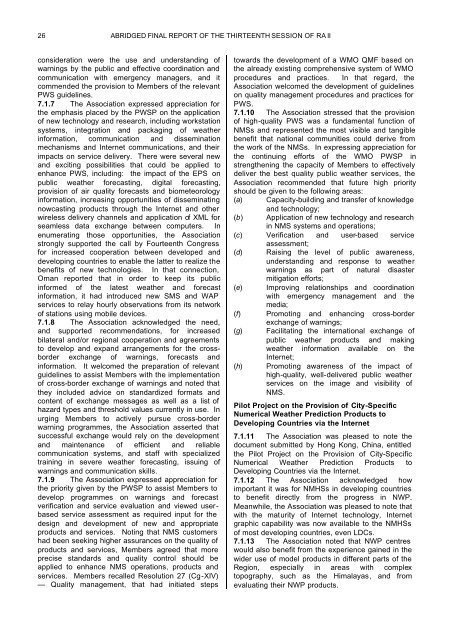Regional Association II (ASIA) - E-Library - WMO
Regional Association II (ASIA) - E-Library - WMO
Regional Association II (ASIA) - E-Library - WMO
You also want an ePaper? Increase the reach of your titles
YUMPU automatically turns print PDFs into web optimized ePapers that Google loves.
26 ABRIDGED FINAL REPORT OF THE THIRTEENTH SESSION OF RA <strong>II</strong>consideration were the use and understanding ofwarnings by the public and effective coordination andcommunication with emergency managers, and itcommended the provision to Members of the relevantPWS guidelines.7.1.7 The <strong>Association</strong> expressed appreciation forthe emphasis placed by the PWSP on the applicationof new technology and research, including workstationsystems, integration and packaging of weatherinformation, communication and disseminationmechanisms and Internet communications, and theirimpacts on service delivery. There were several newand exciting possibilities that could be applied toenhance PWS, including: the impact of the EPS onpublic weather forecasting, digital forecasting,provision of air quality forecasts and biometeorologyinformation, increasing opportunities of disseminatingnowcasting products through the Internet and otherwireless delivery channels and application of XML forseamless data exchange between computers. Inenumerating those opportunities, the <strong>Association</strong>strongly supported the call by Fourteenth Congressfor increased cooperation between developed anddeveloping countries to enable the latter to realize thebenefits of new technologies. In that connection,Oman reported that in order to keep its publicinformed of the latest weather and forecastinformation, it had introduced new SMS and WAPservices to relay hourly observations from its networkof stations using mobile devices.7.1.8 The <strong>Association</strong> acknowledged the need,and supported recommendations, for increasedbilateral and/or regional cooperation and agreementsto develop and expand arrangements for the crossborderexchange of warnings, forecasts andinformation. It welcomed the preparation of relevantguidelines to assist Members with the implementationof cross-border exchange of warnings and noted thatthey included advice on standardized formats andcontent of exchange messages as well as a list ofhazard types and threshold values currently in use. Inurging Members to actively pursue cross-borderwarning programmes, the <strong>Association</strong> asserted thatsuccessful exchange would rely on the developmentand maintenance of efficient and reliablecommunication systems, and staff with specializedtraining in severe weather forecasting, issuing ofwarnings and communication skills.7.1.9 The <strong>Association</strong> expressed appreciation forthe priority given by the PWSP to assist Members todevelop programmes on warnings and forecastverification and service evaluation and viewed userbasedservice assessment as required input for thedesign and development of new and appropriateproducts and services. Noting that NMS customershad been seeking higher assurances on the quality ofproducts and services, Members agreed that moreprecise standards and quality control should beapplied to enhance NMS operations, products andservices. Members recalled Resolution 27 (Cg-XIV)— Quality management, that had initiated stepstowards the development of a <strong>WMO</strong> QMF based onthe already existing comprehensive system of <strong>WMO</strong>procedures and practices. In that regard, the<strong>Association</strong> welcomed the development of guidelineson quality management procedures and practices forPWS.7.1.10 The <strong>Association</strong> stressed that the provisionof high-quality PWS was a fundamental function ofNMSs and represented the most visible and tangiblebenefit that national communities could derive fromthe work of the NMSs. In expressing appreciation forthe continuing efforts of the <strong>WMO</strong> PWSP instrengthening the capacity of Members to effectivelydeliver the best quality public weather services, the<strong>Association</strong> recommended that future high priorityshould be given to the following areas:(a) Capacity-building and transfer of knowledgeand technology;(b) Application of new technology and researchin NMS systems and operations;(c) Verification and user-based serviceassessment;(d) Raising the level of public awareness,understanding and response to weatherwarnings as part of natural disastermitigation efforts;(e) Improving relationships and coordinationwith emergency management and themedia;(f) Promoting and enhancing cross-borderexchange of warnings;(g) Facilitating the international exchange ofpublic weather products and makingweather information available on theInternet;(h) Promoting awareness of the impact ofhigh-quality, well-delivered public weatherservices on the image and visibility ofNMS.Pilot Project on the Provision of City-SpecificNumerical Weather Prediction Products toDeveloping Countries via the Internet7.1.11 The <strong>Association</strong> was pleased to note thedocument submitted by Hong Kong, China, entitledthe Pilot Project on the Provision of City-SpecificNumerical Weather Prediction Products toDeveloping Countries via the Internet.7.1.12 The <strong>Association</strong> acknowledged howimportant it was for NMHSs in developing countriesto benefit directly from the progress in NWP.Meanwhile, the <strong>Association</strong> was pleased to note thatwith the maturity of Internet technology, Internetgraphic capability was now available to the NMHSsof most developing countries, even LDCs.7.1.13 The <strong>Association</strong> noted that NWP centreswould also benefit from the experience gained in thewider use of model products in different parts of theRegion, especially in areas with complextopography, such as the Himalayas, and fromevaluating their NWP products.
















